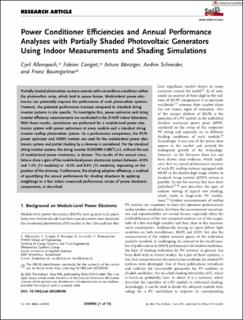Please use this identifier to cite or link to this item:
https://doi.org/10.21256/zhaw-25716Full metadata record
| DC Field | Value | Language |
|---|---|---|
| dc.contributor.author | Allenspach, Cyril Armand | - |
| dc.contributor.author | Carigiet, Fabian | - |
| dc.contributor.author | Bänziger, Arturo | - |
| dc.contributor.author | Schneider, Andrin | - |
| dc.contributor.author | Baumgartner, Franz | - |
| dc.date.accessioned | 2022-09-30T14:10:51Z | - |
| dc.date.available | 2022-09-30T14:10:51Z | - |
| dc.date.issued | 2022 | - |
| dc.identifier.issn | 2367-198X | de_CH |
| dc.identifier.uri | https://digitalcollection.zhaw.ch/handle/11475/25716 | - |
| dc.description.abstract | Partially shaded rooftop photovoltaic systems operate with non-uniform conditions within the photovoltaic array, which lead to power losses. Module-level power electronics can potentially improve the performance of such photovoltaic systems. However, the potential performance increase compared to standard string inverter systems depends on the site-specific details of the installation. To investigate this, power optimizer and string inverter efficiency measurements were conducted in the ZHAW indoor laboratory. With these results, simulations were performed for a module-level power electronics system, for which power optimizers were used at every module, and a standard string inverter photvoltaic system. As a performance comparison, the P370 power optimizer and 3500H inverter was used for the module-level power electronics system and partial shading by a chimney was considered. For the standard string inverter system, the string inverter SUN2000- 3.68KTL-L1, without the use of module-level power electronics was chosen. The results of the annual simulations showed a gain of the module-level power electronics system between 0.9 % and 1.4 % (14-modules) or -0.2 % and 0.8 % (13-modules), depending on the position of the chimney. Furthermore, the shading adaption efficiency, a method of quantifying the annual performance for shading situations by applying weightings to a few indoor measured performance values of power electronic components, is described. | de_CH |
| dc.language.iso | en | de_CH |
| dc.publisher | Wiley | de_CH |
| dc.relation.ispartof | Solar RRL | de_CH |
| dc.rights | http://creativecommons.org/licenses/by/4.0/ | de_CH |
| dc.subject | Module-level power electronics | de_CH |
| dc.subject | Indoor laboratory testing | de_CH |
| dc.subject | Power optimizer | de_CH |
| dc.subject | High-resolution shading simulation | de_CH |
| dc.subject | Photovoltaic system performance | de_CH |
| dc.subject | PV inverter efficiency | de_CH |
| dc.subject.ddc | 621.3: Elektro-, Kommunikations-, Steuerungs- und Regelungstechnik | de_CH |
| dc.title | Power conditioner efficiencies and annual performance analyses with partially shaded photovoltaic generators using indoor measurements and shading simulations | de_CH |
| dc.type | Beitrag in wissenschaftlicher Zeitschrift | de_CH |
| dcterms.type | Text | de_CH |
| zhaw.departement | School of Engineering | de_CH |
| zhaw.organisationalunit | Institut für Energiesysteme und Fluid-Engineering (IEFE) | de_CH |
| dc.identifier.doi | 10.1002/solr.202200596 | de_CH |
| dc.identifier.doi | 10.21256/zhaw-25716 | - |
| zhaw.funding.eu | No | de_CH |
| zhaw.issue | 8 | de_CH |
| zhaw.originated.zhaw | Yes | de_CH |
| zhaw.pages.start | 2200596 | de_CH |
| zhaw.publication.status | publishedVersion | de_CH |
| zhaw.volume | 7 | de_CH |
| zhaw.publication.review | Peer review (Publikation) | de_CH |
| zhaw.webfeed | Photovoltaik | de_CH |
| zhaw.funding.zhaw | EFFPVSHADE – Effizienzanalyse von dezentraler Photovoltaik Leistungselektronik bei Teilbeschattung | de_CH |
| zhaw.author.additional | No | de_CH |
| zhaw.display.portrait | Yes | de_CH |
| Appears in collections: | Publikationen School of Engineering | |
Files in This Item:
| File | Description | Size | Format | |
|---|---|---|---|---|
| 2022_Allenspach-etal_Power-conditioner-efficiencies-partially-shaded-photovoltaics.pdf | 4.48 MB | Adobe PDF |  View/Open |
Show simple item record
Allenspach, C. A., Carigiet, F., Bänziger, A., Schneider, A., & Baumgartner, F. (2022). Power conditioner efficiencies and annual performance analyses with partially shaded photovoltaic generators using indoor measurements and shading simulations. Solar RRL, 7(8), 2200596. https://doi.org/10.1002/solr.202200596
Allenspach, C.A. et al. (2022) ‘Power conditioner efficiencies and annual performance analyses with partially shaded photovoltaic generators using indoor measurements and shading simulations’, Solar RRL, 7(8), p. 2200596. Available at: https://doi.org/10.1002/solr.202200596.
C. A. Allenspach, F. Carigiet, A. Bänziger, A. Schneider, and F. Baumgartner, “Power conditioner efficiencies and annual performance analyses with partially shaded photovoltaic generators using indoor measurements and shading simulations,” Solar RRL, vol. 7, no. 8, p. 2200596, 2022, doi: 10.1002/solr.202200596.
ALLENSPACH, Cyril Armand, Fabian CARIGIET, Arturo BÄNZIGER, Andrin SCHNEIDER und Franz BAUMGARTNER, 2022. Power conditioner efficiencies and annual performance analyses with partially shaded photovoltaic generators using indoor measurements and shading simulations. Solar RRL. 2022. Bd. 7, Nr. 8, S. 2200596. DOI 10.1002/solr.202200596
Allenspach, Cyril Armand, Fabian Carigiet, Arturo Bänziger, Andrin Schneider, and Franz Baumgartner. 2022. “Power Conditioner Efficiencies and Annual Performance Analyses with Partially Shaded Photovoltaic Generators Using Indoor Measurements and Shading Simulations.” Solar RRL 7 (8): 2200596. https://doi.org/10.1002/solr.202200596.
Allenspach, Cyril Armand, et al. “Power Conditioner Efficiencies and Annual Performance Analyses with Partially Shaded Photovoltaic Generators Using Indoor Measurements and Shading Simulations.” Solar RRL, vol. 7, no. 8, 2022, p. 2200596, https://doi.org/10.1002/solr.202200596.
Items in DSpace are protected by copyright, with all rights reserved, unless otherwise indicated.